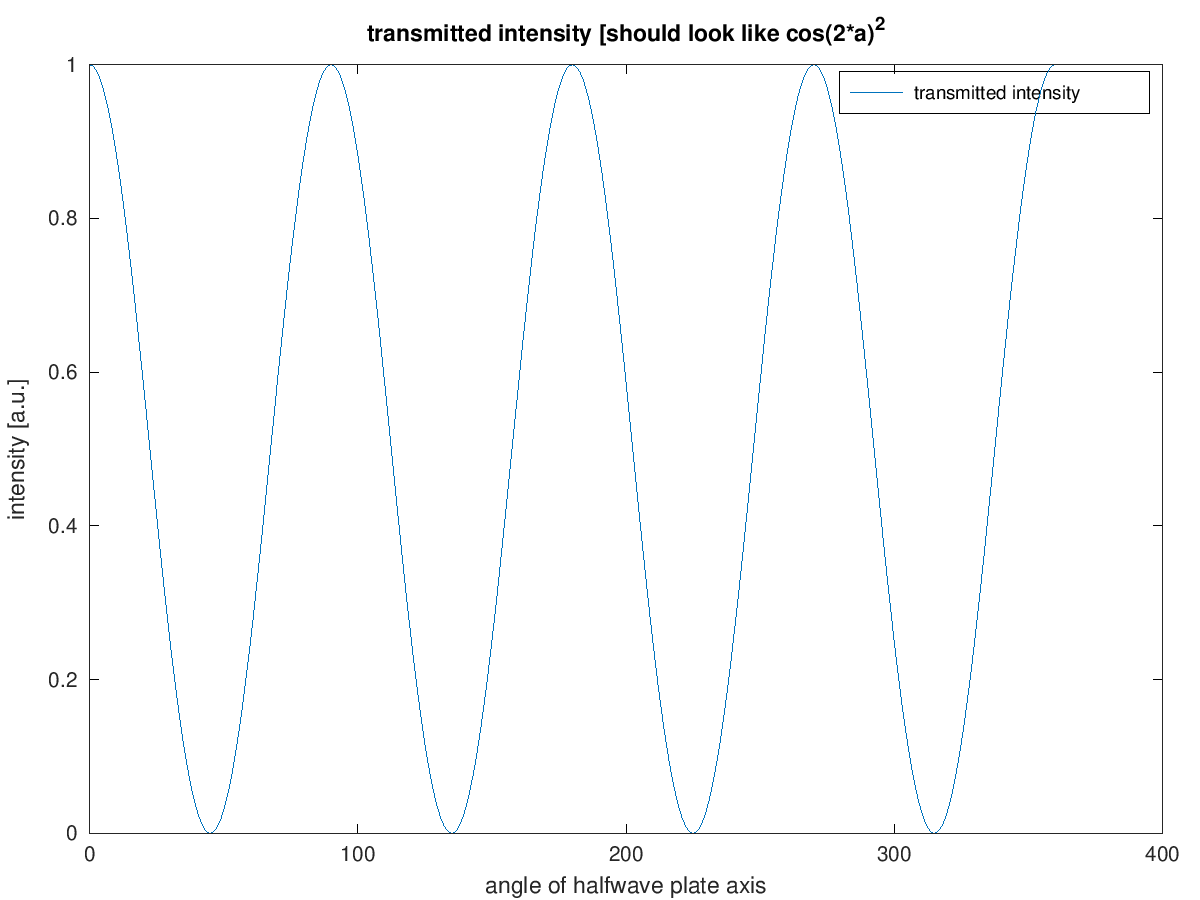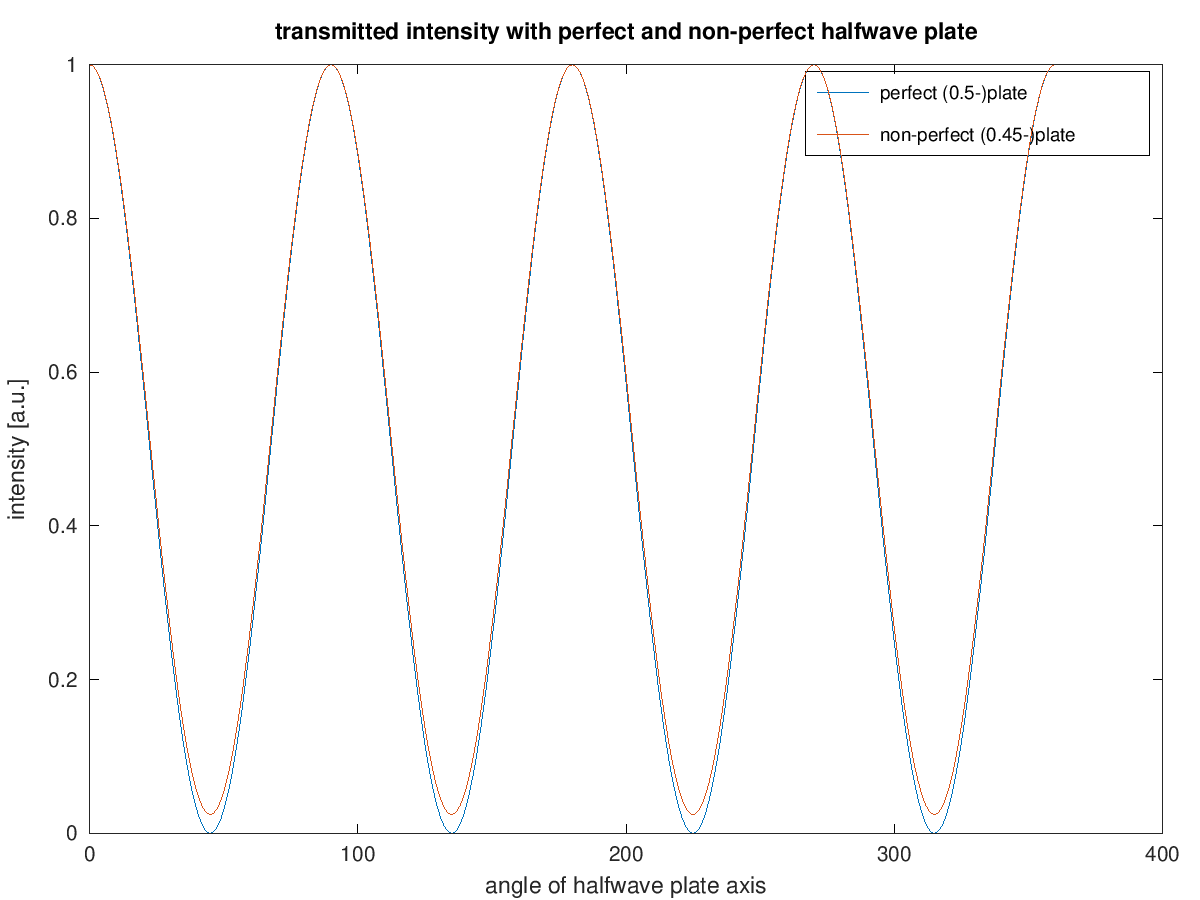- Function File: M = mueller_stokes(M)
- Function File: A = mueller_stokes(M,N,...)
Multiply Mueller matrices and Stokes vectors.
- - M,N,... define Mueller matrices or Stokes vectors. The function will multiply these from left to right and return the result.
M,N,... can be passed as either numeric matrices/vectors or cell arrays. In this case, the multiplication is carried out in a ".*" manner.
References:
- E. Collett, Field Guide to Polarization, SPIE Field Guides vol. FG05, SPIE (2005). ISBN 0-8194-5868-6.
- R. A. Chipman, "Polarimetry," chapter 22 in Handbook of Optics II, 2nd Ed, M. Bass, editor in chief (McGraw-Hill, New York, 1995)
- "Mueller calculus", last retrieved on Dec 17, 2013.
See also: mueller_checkmueller.
Demonstration 1
The following code
angles = 0:360;
wps = mueller_rotate(mueller_waveplate(0.5, 'wav'), angles, 'deg');
lightin = stokes_lphorizontal();
lightout = mueller_stokes(mueller_linpolarizer(),wps,lightin);
ilightout = stokes_intensity(lightout);
figure();
plot(angles, ilightout);
title('transmitted intensity [should look like cos(2*a)^2');
xlabel('angle of halfwave plate axis');
ylabel('intensity [a.u.]');
legend('transmitted intensity');
% -----------------------------------------------------------------
% example 1: send light with horizontal linear polarization through
% a rotating, perfect halfwave plate and subsequent polarizer:
% final intensity should vary as cos(2*angle)^2.
Produces the following figure
| Figure 1 |
|---|
 |
Demonstration 2
The following code
angles = 0:360;
wps = mueller_rotate(mueller_waveplate(0.5, 'wav'), angles, 'deg');
wps2 = mueller_rotate(mueller_waveplate(0.45, 'wav'), angles, 'deg');
lightin = stokes_lphorizontal();
lightout = mueller_stokes(mueller_linpolarizer(),wps,lightin);
ilightout = stokes_intensity(lightout);
lightout2 = mueller_stokes(mueller_linpolarizer(),wps2,lightin);
ilightout2 = stokes_intensity(lightout2);
figure();
plot(angles, ilightout, angles, ilightout2);
title('transmitted intensity with perfect and non-perfect halfwave plate');
xlabel('angle of halfwave plate axis');
ylabel('intensity [a.u.]');
legend('perfect (0.5-)plate', 'non-perfect (0.45-)plate');
% -----------------------------------------------------------------
% example 2: send light with horizontal linear polarization through
% a rotating, non-perfect halfwave plate and subsequent polarizer:
% final intensity should deviate from the perfect cos(2*angle)^2
% curve, never reaching zero transmission
Produces the following figure
| Figure 1 |
|---|
 |
Demonstration 3
The following code
angle = 0:360;
delay = 0:0.05:1;
% angles are in rows, delays in columns
angle_all = repmat(angle, [length(delay), 1]);
delay_all = repmat(delay', [1, length(angle)]);
wps3 = mueller_waveplate(delay_all, 'wav');
wps3 = mueller_rotate(wps3, angle_all, 'deg');
lightin = stokes_lphorizontal();
lightout3 = mueller_stokes(mueller_linpolarizer(),wps3,lightin);
ilightout3 = stokes_intensity(lightout3);
figure();
plot(angle, ilightout3);
title('transmitted intensity with plates of increasing delay');
xlabel('angle of plate axis');
ylabel('intensity [a.u.]');
legend(cellfun(@(x)sprintf('delay=%.2f',x),num2cell(delay),'UniformOutput',false));
% -----------------------------------------------------------------
% example 3: send light with horizontal linear polarization through
% rotating waveplates with increasing delay and subsequent polarizer
Produces the following figure
| Figure 1 |
|---|
 |
Package: optics